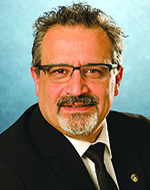Page Content
How the World Has Grown
 Moving beyond the classroom walls (and the province’s borders) offers rich rewards
Moving beyond the classroom walls (and the province’s borders) offers rich rewards
I remember when the world around me in education consisted of the four walls of my classroom. Issues focused on what I was doing to survive. My career began to progress, creativity in my class was a goal, and working with students beyond just my classroom became the norm. There was more emphasis on the school as a whole, and being part of the school community became a goal I aspired to.
My curiosity was enhanced as my handle on school and class activity was no longer a struggle. My awareness now included other schools within my district. I started coaching and the world grew once more. On occasion there would be contact with schools outside of Edmonton as tournaments would take my team to faraway places such as Calgary, Winnipeg or Vancouver. Yes sir, I was really growing up as an educator and the world was a bigger place.
My view changed once again as my career shifted and participation in the local and the broader Alberta Teachers’ Association became more significant. I became a local president and suddenly there was a province to consider. Issues impacting Alberta’s public education system as a whole were epicentres of activity. My view of education, the system in which we work, and the views and value of public education have continually developed up to this day. Along the way I’ve had the privilege to serve our profession as the president of the ATA and discovered that education issues are truly common across the country.
The days of being so insular or “classroom only” focused are gone. Decisions made by the Alberta Teachers’ Association, for example, are founded in research and are debated at our Annual Representative Assembly (ARA). Rarely if ever are sound educational decisions made based on opinion. This is why we continually seek new information and fresh ideas. We choose to develop and pay for our own education research so we can look at the needs of our members. We are annually approached by others and we choose to participate in their education research. World-recognized researchers in Alberta, from across Canada and from around the world look to the ATA for support, advice and partnerships when choosing to conduct education research projects and we, as an association of professional teachers, answer the call.
I’ve had the opportunity to heighten my awareness of the national and international scene, and I can tell you that education really is a global phenomenon and the fight for public education is very real. I am often asked by colleagues, parents and people in industry if it is important or necessary to reach beyond Alberta’s borders to answer burning education questions and develop accompanying research. Of course, I answer yes!
Developing strong international relationships within the global education community is vital to staying abreast of the trends driving the global education policy agenda. Global trends, issues and ideas find their way to Alberta and we must be prepared to deal with the consequences. Keep in mind, however, that information, strategy and thought do not just flow into our province. Other governments, national unions and education partners also come to Alberta to partner, share and learn with us.
Countries included in our list of partners include Finland, Norway and New Zealand. One focus of our Finnish partnership is a public assurance model that’s less reliant on high-stakes testing, along with teacher accountability being replaced by teacher responsibility, as well as the infiltration of the Global Education Reform Movement (GERM). Issues impacting math and its delivery are fundamental to the NORCAN partnership with our Norwegian colleagues. In both of these cases, school visits with both teachers and students bring the partnerships to life as we share our expertise from the perspective of Alberta teachers.
Others also learn from us. Singapore, for example, sent a delegation to Alberta to meet with the ATA and learn about our structure. The delegation members wanted to know what makes the ATA special as a teacher organization. They spent several days with us learning about how we accomplish our goals and objectives. We’ve also had invitations from Harvard’s Graduate Studies in Education and GELP in New Zealand, both wanting to know more about our organizational structure and details about how we serve our members.
Not all our partnerships are grandiose in structure and formality, but all are important. We maintain our stature within the international education community because of who we are, what we do and knowing why we are doing it. From my point of view, international partnerships are invaluable. We have built relationships with so many players in the international education community. We call many of these people friends of Alberta teachers. I have developed personal relationships with many government representatives, international and national researchers, and union leaders from around the globe. So if asked if international partnerships and relationships are worth it, my answer is a definite yes!
